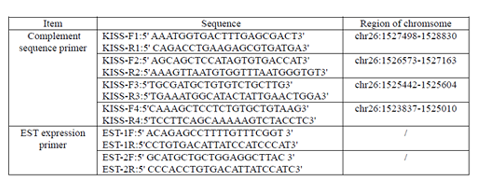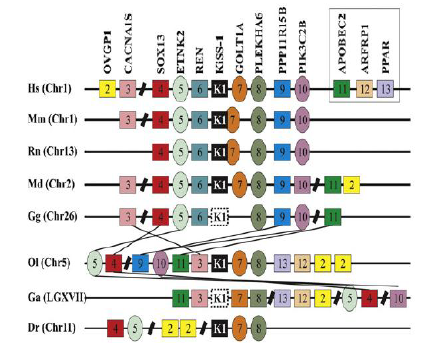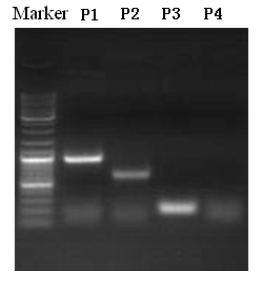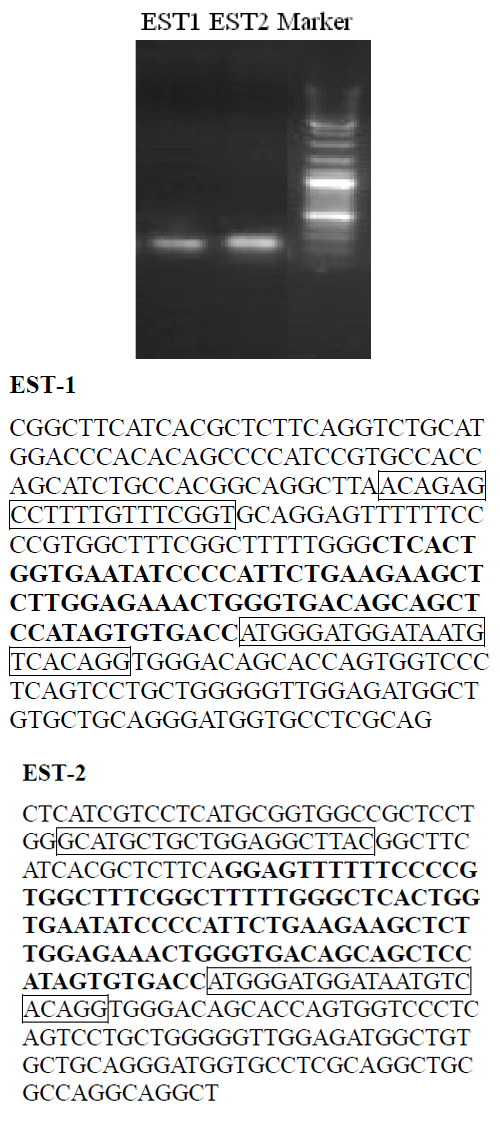Information
Journal Policies
Clone of Chicken KISS-1 Like Gene and Expression Analysis of Relevant ESTs
Liu Li, Wu Cai-Hong, Zuo Wei-Yong, Wu Zhi, Hao Fu-Xing*
Copyright :© 2018 Authors. This is an open-access article distributed under the terms of the Creative Commons Attribution License, which permits unrestricted use, distribution, and reproduction in any medium, provided the original author and source are credited.
Puberty onset is a complex biological process. The increased pulsatile release of gonadotrophin releasing hormone (GnRH) from the hypothalamus is the determined event. Kisspeptins, encoded by KISS-1 gene, can directly promote GnRH secretion through its receptor GPR54 and initiate the puberty process. So, KISS-1/GPR54 system is considered as the gatekeeper of puberty onset. However, to date the avian KISS-1gene has still not been interpreted clearly in GenBank. In this study, we determine the chr 26:1522493-1532710 as the candidate region to clone KISS-1 like gene for chicken by analyzing the distribution of KISS-1 and its up-/down-stream genes in other species. The sequence of this region is complemented by PCR and sequencing. Nine relevant ESTs that match to the region with 50% ~ 65% similarity are found by BLAST, and two novel prolonged ESTs are found to express in the chicken hypothalamus.
puberty onset; chicken; KISS-1 like gene; EST sequence
1. Introduction
Although precocious puberty is pathologic for humans, it is an important trait for animal breeding and production [1, 2]. Puberty onset is a complex biological process, and is under the control of Hypothalamic-Pituitary-Gonadal Axis (HPGA). The increased pulsatile release of gonadotrophin releasing hormone (GnRH) from the hypothalamus is the determined and final event for puberty onset [3]. In the past few years, many environmental and metabolic factors were found to influence puberty onset, and several hypothesis were suggested, including “permissive signals”, “gonadostat” and “developmental clock” [3]. However, all these factors exerted their effects through genetic pathways. It had been suggested that the genetic contribution to puberty onset was about 50%~60%. Therefore, identifying genes related to puberty onset attracted more attention, and much progress had been made. Many genes are found to be involved in the initiation of puberty, such as GnRH/GnRHR, GABA/GABRA1, KISS-1/GPR54, TAC3/TACR3, LIN28A/B, NPY and leptin systems [4-7]. Especially, the KISS-1/GPR54 system was considered as the gatekeeper of puberty onset [8]. To date, the KISS-1 gene sequences in mammalian, human, rodent, amphibian, fish and other species have been cloned. However, the avian KISS-1 sequences are still not interpreted clearly in GenBank.
After a long history of selection and evolution, the Chinese indigenous chicken breeds are endowed with distinctive characters of precocious puberty. Some breeds can lay the first egg at the age of 110d~120d, which are predated by more than twenty days compared to the internationally famous breeds. Investigating genes that control chicken puberty onset will aid to breed high production layers and high meat quality broilers. The objective of this study is to identify the KISS-1 like gene in the chicken by comparative genomics.
2. Materials And Methods
A Chinese indigenous chicken breed with obvious features of precocious puberty was used as the material in this study. The hypothalamic tissues of females at 13 week when the gonads just entered into rapid development were homogenized in Trizol and stored at -20°C. The total RNA was extracted by RNA prep pure tissue kit according to the manufacturer’s protocol (Ambion). The DNA was extracted by phenol-chloroform method and stored at 4°C
The KISS-1 and its down-/up-stream genes on chromosome in different species were analyzed by online UCSC (http://genome.ucsc.edu), Ensemble (http://www.ensembl.org),
NCBI (http://www.dtd.nlm.nih.gov), arrangement of these genes was showed in Figure 1. The KISS-1 like gene for chicken was located between REN gene and PLEKHA6 gene, covering chr26:1522493-1532710 region on chromosome. The sequence of this region in GenBank was not intact for chicken. Four paired primers were designed by Primer Premier 6.0 to complement this region sequences (Table 1). The ESTs that match to chicken chr26:1522493-1532710 region were identified by BLAST programme. The primers to test novel prolonged ESTs expression were also designed by Primer Premier 6.0 (Table 1).
50μl PCR reagents included DNA 1μl, primer 2μl, dNTP 1μl (10 mM), Taq Buffer 5μl, MgCl2 5μl (25mM), Taq polymerase 0.5μl(5U, H2O35.5μl. PCR reaction protocol was as followed, 95°C,3min; 94°C, 30s; 60°C, 35s; 72°C, 30S; 72°C, 10min, 35 cycles. The PCR products were purified by SK1131 KIT。10 X l connected system included 10-Ligation Buffer Ligation Buffer Ligation BufferLigation Buffer Ligation BufferLigation Buffer Ligation Buffer , 1µl 50%PEG, 50ng pUCm - T VectorT VectorT VectorT Vector , 0.2 pmol PCR products, 2.5U T4 DNA Ligase. 2ug total RNA was reverse-transcripted into cDNA by Superscript RT following the manufacturer,s protocol (Invitrogen).
3. Results
Agarose gel electrophoresis of PCR products for complementing chr26:1522493-1532710 region was showed in Figure 2. All the four paired primers amplified PCR products with different length.
Based on the obtained sequences of chicken chr26:1522493-1532710 region, BLAST programme was performed and nine relevant ESTs that matched to this region with 50% ~ 65% similarity were found (Accession No: BU337828, BU298299, BU305010, AI980167, BU398959, CD740208, BU397302, BU303043, BU301557). After sequence comparison and prolonging, two novel ESTs were acquired. The primers for the two novel ESTs could amplify PCR products in chicken hypothalamic tissue cDNAs (Figure 3). It showed that the two ESTs were expressed in chicken hypothalamus.
4. Discussion
KISS-1 gene was firstly found and named by Lee and colleagues in 1996 [10]. when they focused on human malignant melanoma metastasis- suppressor genes. KISS-1 gene was located on 1q32 in human, including four exons. Its encoding product, kisspeptin, could decompose to Kisspeptin-54, 14, -13 and -10 that had similar activities [11]. GPR54 was the receptor of kisspeptin. Previous studies about KISS-1 gene mainly focused on its role in tumor suppress.
In 2003, two independent groups reported the loss function mutation of GPR54 in nIHH patients [12, 13]. Then kisspeptin/GPR54 system attracted more attention to investigate its roles in puberty. kisspeptin/GPR54 system had been considered as the gatekeeper of puberty onset, the evidence was as following: (1) KISS-1 and GPR54 mainly expressed in hypothalamic arcuate nucleus [14-16], where GnRH gene also expressed; (2) KISS-1 and GPR54 expression levels significantly increased at pre-puberty stage [16-18]; (3) a low dose of kisspeptin, either central or peripheral injection, could promote GnRH-dependent LH and FSH secretion [19-21]; (4) KISS-1 and GPR54 knockdown mouse had no puberty onset, immature sexual organs and lower steroid hormone level [20,22].(5) KISS-1 might directly induced GnRH secretion through GPR54 receptors and initiated the puberty process [12,16,17,21]. In humans, Luan et al (2007) [23] screened the KISS-1 sequence mutations in 315 GDPP patients, including 272 Chinese girls, 43 african girls and 288 healthy Chinese girls as controls. Eight mutations were found, however, only one has significant correlation with GDPP. Vries et al (2009) [24] suggested that the serum kisspeptin level is an important marker for clinic diagnose of precocious puberty. Silveira et al (2010) [25] also screened the KISS-1 sequence mutations in 83 GDPP patients, including 77 girls and 6 boys, two rare mutations p.P74S and p.H90D were found.
To date, avian KISS-1 gene has not been reported. Some researchers even suggest avian KISS-1 gene should be lost in the evolution [26]. In 2010, Saldanha et al [27] firstly reported neurons that co-localize aromatase- and kisspeptin-like immunoreactivity might regulate the HPG axis of the Mallard drake (Anas platyrhynchos). Xiao et al (2012) [28] investigated the effect and mechanism of Kisspeptin-10 (Kp-10) on progesterone (P4) secretion in cultured granulose cells of chicken follicles, and found the cells were kisspeptin- positive expression with specific antibody against Kp-10. The results implied KISS-1 gene might be involved in avian puberty onset. Therefore, in this study we firstly analyzed the location of KISS-1 and its up-/down-stream genes in different species, then determined the candidate region chr26:1522493-1532710 for chicken, and termed it as KISS-1 like region.
EST sequences were short cDNA sequences, and were often used in gene location and gene clone [29]. In this study, BLAST method was used to find ESTs that matched to chr26:1522493- 1532710 region, and nine ESTs with 50%~65% similarity were found. After prolonging, two novel ESTs were acquired. PCR amplification showed the two ESTs were expressed in the hypothalamus. In addition, we also found the hypothalamic expression level of the two ESTs increased significantly in the pre-puberty stage of Wenchang chicken (the data was not listed). So, the two ESTs may play important roles in the chicken puberty onset.
5.Acknowledgement
This work was supported by the Jiangsu Province Science and Technology Support Project & Jiangsu Qing-Lan Project. It was financially supported by Jiangsu Province “three new” project (JATS [2018] 240).
References
- CHU Ming-Xing, FENG Tao, DI Ran, et al. Advances on related genes with sexual precocity in mammals. HEREDITAS, 2009,31(10):13-28.
- Chen kuanwei. The development of Chinese high quality chickens. Chinese avian, 2010,32(19):1-4.
- Cheryl L S and Douglas L F. The neural basis of puberty and adolescence. Nature Neuroscience. 2004, 7(10):1040-1046.
- Zieba D A, Amstalden M, Williams G L. Regulatory roles of leptin in reproduction and metabolism: A comparative review. Domestic Animal Endocrinology. 2005, 1(29): 166-185.
- Ojeda S R, Dubay C, Lomniczi A, Kaidar G, Matagne V, Sandau US, Dissen G A. Gene networks and the neuroendocrine regulation of puberty. Mol Cell Endocrinol, 2010, 324: 3–11.
- Perry J R, Stolk L, Franceschini N, et al. Meta- analysis of genome-wide association data identifies two loci influencing age at menarche.Nat Genet, 2009doi:10.1038/ng.386
- A Kemal T, Frank R, Metin G, et al. TAC3 and TACR3 mutations in familial hypogonadotropic hypogonadism reveal a key role for Neurokinin B in the central control of reproduction. Nat Genet, 2009, 3(41): 354-358.
- Iain J C. Control of GnRH secretion: one step back. Frontiers in Neuroendocrinology, 2011, 32: 367-375.
- Alicia F, Silvia Z, Rafael P, et al. Evidence for two distinct KiSS genes in non-placental vertebrates that encode kisspeptins with different gonadotropin-releasing activities in fish and mammals. Molecular and Cellular Endocrinology, 2009, 312: 61–71.
- Lee J H, Miele M E, Hicks D J, et al. KiSS-1, a novel human malignant melanoma metastasis- suppressor gene. J Natl Cancer Inst, 1996, 88(23):1731-1737.
- Muir A I, Chamberlain L, Elshourbagy N A, et al. a novel human G protein-coupled receptor, activated by the peptide KiSS-1. J Biol Chem,2001,276(31):28969-28975.
- de Roux N, Genin E, Carel J C, et al. Hypogonadotropic hypogonadism due to loss of function of the KiSS1-derived peptide receptor GPR54. Proc Natl Acad Sci USA, 2003, 100(19):10972-10976.
- Seminara S B, Messager S, Chatzidaki E E, et al. The GPR54 gene as a regulator of puberty. N Engl J Med, 2003, 349(17):1614-1627.
- Pompolo S, Pereira A, Estrada K M, et al. Colocalization of kisspeptin and gonadotropin- releasing hormone in the ovine brain. Endocrinology, 2006, 147(2):804-810.
- Revel F G, Ansel L, Klosen P, et al. Kisspeptin: a key link to seasonal breeding. Rev Endocr Metab Disord, 2007, 8(1):57-65.
- Smith J T, Clarke I J. Kisspeptin expression in the brain: catalyst for the initiation of puberty. Rev Endocr Metab Disord, 2007, 8(1):1-9.
- Tena-Sempere M. The roles of kisspeptins and G protein-coupled receptor-54 in pubertal development. Curr Opin Pediatr, 2006, 18(4):442-447.
- Plant T M, Ramaswamy S, Dipietro M J. Repetitive activation of hypothalamic G protein- coupled receptor 54 with intravenous pulses of kisspeptin in the juvenile monkey (Macaca mulatta) elicits a sustained train of gonadotropin-releasing hormone discharges. Endocrinology, 2006, 147(2):1007-1013.
- Irwig M S, Fraley G S, Smith J T, et al. Kisspeptin activation of gonadotropin releasing hormone neurons and regulation of KiSS-1 mRNA in the male rat. Neuroendocrinology, 2004,80(4):264-272.
- Lapatto R, Pallais J C, Zhang D, et al. Kiss1-/- mice exhibit more variable hypogonadism than Gpr54-/- mice. Endocrinology, 2007, 148(10):4927-4936.
- Messager S, Chatzidaki E E, Ma D, et al. Kisspeptin directly stimulates gonadotropin- releasing hormone release via G protein-coupled receptor 54. Proc Natl Acad Sci USA, 2005, 102(5):1761-1766.
- Colledge W H. GPR54 and puberty. Trends Endocrinol Metab, 2004, 15(9):448-453.
- Luan, X., Yu, H., Wei, X., et al.. GPR54 polymorphisms in Chinese girls with central precocious puberty. Neuroendocrinology, 2007, 86, 77–83.
- Viswanathan, S. R., Daley, G. Q., Gregory, R.I. Selective blockade of microRNA processing by Lin28. Science, 2008, 320, 97–100.
- Silveira, L.F., Trarbach, E.B., Latronico, A.C. Genetics basis for GnRH dependent pubertal disorders in humans. Mol Cell Endocrinol, 2010, 324, 30–38.
- Shuisheng Li, Yong Zhang, Yun Liu, et al. Structural and functional multiplicity of the kisspeptin/GPR54 system in goldfish (Carassius auratus). Journal of Endocrinology, 2009, 201, 407–418.
- Colin J S, Bradley J W, Gregory S F. Neurons that co-localize aromatase- and kisspeptin-like immunoreactivity may regulate the HPG axis of the Mallard drake (Anas platyrhynchos). General and Comparative Endocrinology, 2010, 166 :606–613.
- XIAO Yun-qi, HUANG Yan-bing, WU Jing, et al. Effect and mechanism of Kisspeptin-10 on progesterone secretion in granulosa cells of chicken F1 follicles cultured in serum-free medium. Scientia Agricultura Sinica, 2012,45(2):391-398.
- LIU Yuan, CAI Jia-Bin, JIANG Guo-Song, et al. Strategies for cloning of novel genes based on EST. HEREDITAS, 2008, 30(3): 257-262.








